Table of Contents
- Machine Learning in Medical Insurance
- About the Data
- Importing required Libraries
- Importing Dataset
- Data Analysis
- Data Pre – Processing
- Splitting the Features and Target
- Splitting Dataset into Training data & Testing data
- Model Selection & Model Training
- Model Evaluation
- Building a Predictive System
- Conclusion
About Medical Insurance
Before creating Medical Insurance Cost Prediction model, Let’s understand what is Medical Insurance and how it can help us. Medical Insurance is a type of Insurance that covers yours medical expenses that arise due to an illness. These can be related to medicine cost, Doctor consultation fee, procedures or hospitalization cost etc.
Machine Learning in Medical Insurance
In this we will discuss about the Problem Statement of our Project it says that :- An Insurance Company wants to predict medical insurance cost of a person using Machine Learning by providing relevant data.
That cost predicted by our machine learning model will be suggested to their customer who wants to buy a medical insurance from that company. In developed economies there are various stakeholders, namely buyer, insurer and health care service provider. The objectives of all the stake holders are different. A lot of automation using ML is implemented these days, for instance AI based appointment voice BOT is used to reduce call abandonment rate. We would cover this implementation in some other project. For now lets focus on the Insurance cost assessment.
Importing required Libraries
import numpy as np
import pandas as pd
import matplotlib.pyplot as plt
import seaborn as sns
from sklearn.model_selection import train_test_split
from xgboost import XGBRegressor
from sklearn import metrics
import warnings
warnings.filterwarnings('ignore')
About the Data
Let’s explore the data. In this dataset there are some details like Age, Sex, BMI, Children, Smoker, Region and Charges. Download the data by clicking on this link, Medical Insurance Data.
Importing Dataset
df = pd.read_csv("medical-insurance-data.csv")
# first 5 rows of the dataframe
df.head()
age sex bmi children smoker region charges
0 19 female 27.900 0 yes southwest 16884.92400
1 18 male 33.770 1 no southeast 1725.55230
2 28 male 33.000 3 no southeast 4449.46200
3 33 male 22.705 0 no northwest 21984.47061
4 32 male 28.880 0 no northwest 3866.85520
# number of rows and column
df.shape
(1338, 7)
# getting some informations about the dataset
df.info()
RangeIndex: 1338 entries, 0 to 1337
Data columns (total 7 columns):
# Column Non-Null Count Dtype
--- ------ -------------- -----
0 age 1338 non-null int64
1 sex 1338 non-null object
2 bmi 1338 non-null float64
3 children 1338 non-null int64
4 smoker 1338 non-null object
5 region 1338 non-null object
6 charges 1338 non-null float64
dtypes: float64(2), int64(2), object(3)
memory usage: 73.3+ KB
There are no null values in the dataset
Data Analysis
# Statistical Measures of the dataset df.describe() age bmi children charges count 1338.000000 1338.000000 1338.000000 1338.000000 mean 39.207025 30.663397 1.094918 13270.422265 std 14.049960 6.098187 1.205493 12110.011237 min 18.000000 15.960000 0.000000 1121.873900 25 per .000000 26.296250 0.000000 4740.287150 50 per 9.000000 30.400000 1.000000 9382.033000 75 per .000000 34.693750 2.000000 16639.912515 max 64.000000 53.130000 5.000000 63770.428010
# distribution of age value sns.set() plt.figure(figsize=(8,6)) sns.distplot(df['age']) plt.title('Age Distribution') plt.show()
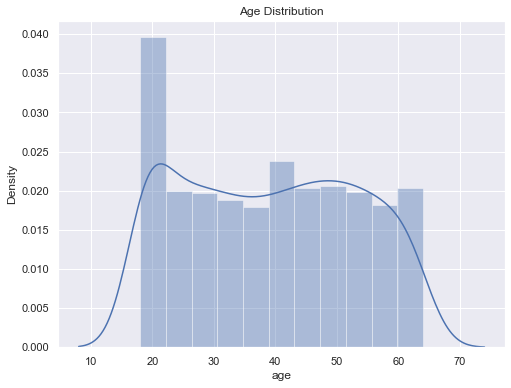
Figure 1 : Plot of Age Distribution
# Gender column plt.figure(figsize=(7,6)) sns.countplot(x = 'sex', data = df) plt.title('Gender Distribution', fontsize = 15, fontweight = 'bold') plt.show()
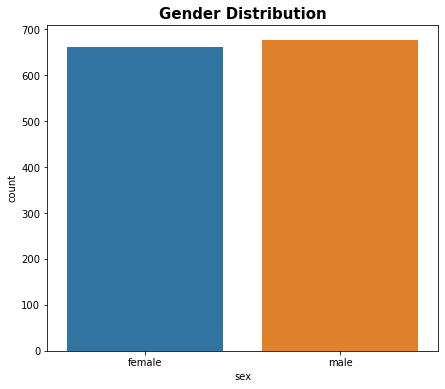
Figure 2 : Plot of Gender Distribution
df['sex'].value_counts()
male 676
female 662
Name: sex, dtype: int64
# bmi distribution plt.figure(figsize=(8,6)) sns.distplot(df['bmi']) plt.title('BMI Distribution', fontsize = 15, fontweight = 'bold') plt.show()
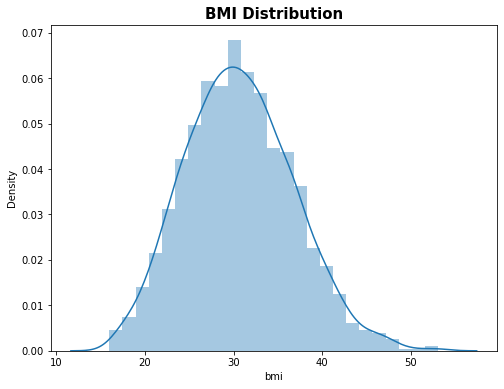
Figure 3 : Plot of BMI Distribution
# children column
plt.figure(figsize=(6,6))
sns.countplot(x = 'children', data = df)
plt.title('Children', fontsize = 15, fontweight = 'bold')
plt.show()
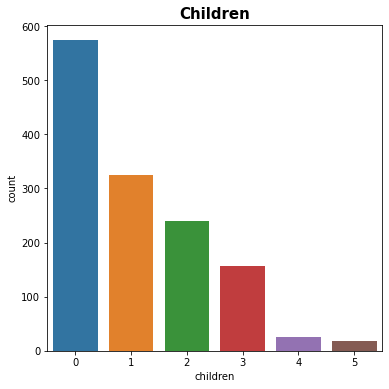
Figure 4 : Plot of Children Distribution
df['children'].value_counts()
0 574
1 324
2 240
3 157
4 25
5 18
Name: children, dtype: int64
# smoker column plt.figure(figsize=(6,6)) sns.countplot(x = 'smoker', data = df) plt.title('Smoker', fontsize = 15, fontweight = 'bold') plt.show()
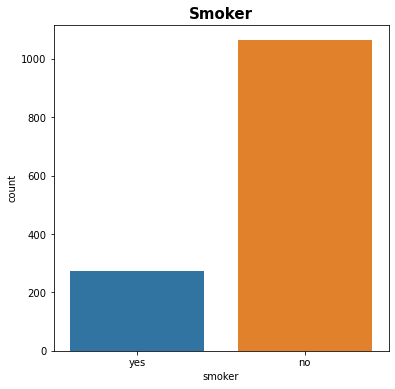
Figure 5 : Plot of Smoker Distribution
df['smoker'].value_counts()
no 1064
yes 274
Name: smoker, dtype: int64
# region column plt.figure(figsize=(6,6)) sns.countplot(x = 'region', data = df) plt.title('Region', fontsize = 15, fontweight = 'bold') plt.show()
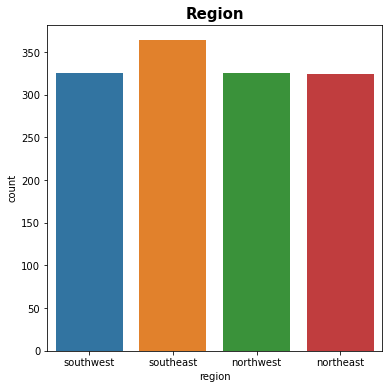
Figure 6 : Plot of Region Distribution
df['region'].value_counts()
southeast 364
northwest 325
southwest 325
northeast 324
Name: region, dtype: int64
# distribution of charges value plt.figure(figsize=(8,6)) sns.distplot(df['charges']) plt.title('Charges Distribution', fontsize = 15, fontweight = 'bold') plt.show()
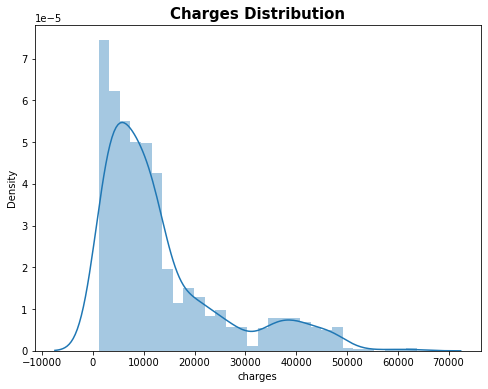
Figure 7 : Plot of Charges Distribution
Data Pre-Processing
Encoding the categorical features
Replace male & female with 0 & 1 respectively. Replace yes & no in smoker with 0 and 1 respectively. Replace southeast, southwest, northeast and northwest with 0, 1, 2, 3 respectively.
# replacing male & female column with 0 & 1 respectively
df.replace({'sex':{'male':0,'female':1}}, inplace=True)
# replacing smoker yes & no column with 0 & 1 respectively
df.replace({'smoker':{'yes':0,'no':1}}, inplace=True)
# replacing southeast, southwest, northeast, northwest column with 0, 1, 2, 3 respectively
df.replace({'region':{'southeast' :0,'southwest':1,'northeast':2,'northwest':3}}, inplace= True)
Splitting the Features and Target
X = df.drop(columns='charges', axis = 1)
y = df['charges']
print(X)
age sex bmi children smoker region
0 19 1 27.900 0 0 1
1 18 0 33.770 1 1 0
2 28 0 33.000 3 1 0
3 33 0 22.705 0 1 3
4 32 0 28.880 0 1 3
... ... ... ... ... ...
1333 50 0 30.970 3 1 3
1334 18 1 31.920 0 1 2
1335 18 1 36.850 0 1 0
1336 21 1 25.800 0 1 1
1337 61 1 29.070 0 0 3
[1338 rows x 6 columns]
print(y)
0 16884.92400
1 1725.55230
2 4449.46200
3 21984.47061
4 3866.85520
...
1333 10600.54830
1334 2205.98080
1335 1629.83350
1336 2007.94500
1337 29141.36030
Name: charges, Length: 1338, dtype: float64
Splitting the dataset into Training Data & Testing Data
X_train, X_test, y_train, y_test = train_test_split(X, y, test_size = 0.2, random_state = 2)
print(X_train.shape)
print(X_test.shape)
print(y_train.shape)
print(y_test.shape)
(1070, 6)
(268, 6)
(1070,)
(268,)
Model Training
XGBoost Regressor
# loading the model model = XGBRegressor() # training the model with X_train, y_train model.fit(X_train, y_train) XGBRegressor(base_score=0.5, booster='gbtree', colsample_bylevel=1, colsample_bynode=1, colsample_bytree=1, gamma=0, gpu_id=-1, importance_type='gain', interaction_constraints='', learning_rate=0.300000012, max_delta_step=0, max_depth=6, min_child_weight=1, missing=nan, monotone_constraints='()', n_estimators=100, n_jobs=4, num_parallel_tree=1, random_state=0, reg_alpha=0, reg_lambda=1, scale_pos_weight=1, subsample=1, tree_method='exact', validate_parameters=1, verbosity=None)
Model Evaluation
train_data_prediction = model.predict(X_train)
print(train_data_prediction)
[ 2322.9866 6243.888 11853.557 ... 12549.385 10701.751 12098.009 ]
# Getting R squared value for training dataset
r2_train = metrics.r2_score(y_train, train_data_prediction)
print('R squared value for training dataset : ', r2_train)
R squared value for training dataset : 0.9962665931681515
R square value lies in range of 0 to 1. The more it is closer to 1 , more the model will perform well.
test_data_prediction = model.predict(X_test)
# R squared value for testing dataset
r2_train = metrics.r2_score(y_test, test_data_prediction)
print('R squared value for testing dataset : ', r2_train)
R squared value for testing dataset : 0.8217591365018906
Building a Predictive system
# Replace male & female with 0 & 1 respectively. # Replace yes & no in smoker with 0 and 1 respectively. # Replace southeast, southwest, northeast and northwest with 0, 1, 2, 3 respectively. input_data = (21,1,16.815,1,1,2) # changing input_data to a numpy array input_data_as_numpy_array = np.asarray(input_data) # reshape the array input_data_reshaped = input_data_as_numpy_array.reshape(1,-1) prediction = model.predict(input_data_reshaped) print('The insurance cost is', prediction[0]) The insurance cost is 3166.413
Conclusion
Here above we have successfully build a Machine Learning model using XGBoost Regressor and predicted the cost of Insurance. But, before that we have collected
- The data
- Imported necessary libraries
- Performed data pre – processing
- Analyzed data Visually
- Split the data into training and testing data
- Selecting and Training Model
- Performed Model Evaluation.
- And at last we build a predictive system.
You can add more layers to this for optimizing your model, for instance you can use cross validation's to generalize the model. Have a look at this application of Cross Validation.
About the Author's:

Write A Public Review